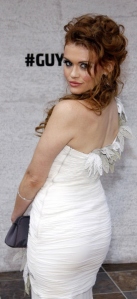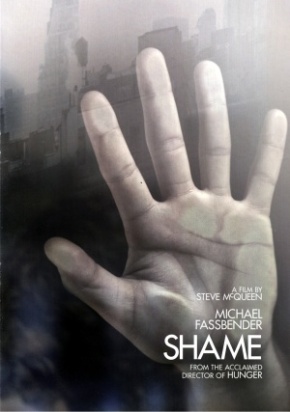Who decides that 1am is a good time to start a movie about imprisoned IRA members embarking on a fatal hunger strike? That would be me. Up until a few days ago, I’d never heard of Hunger (the story of Bobby Sands, the first of ten men to die during a 1981 hunger strike protesting the treatment of IRA members in the Maze prison and demanding they be classified as political prisoners) but once I had I was deeply intrigued, hence my decision to sacrifice a night’s sleep. It wasn’t just watching the film that prevented me from getting a reasonable eight hours though; there was no way I was going right to bed afterward. It felt as though images from it had been seared into my frontal lobes. In fact, it still feels that way. Every shot is so beautiful, so artfully composed, each one poetry, and yet their content is stomach-turning, brutally harsh and raw. I don’t think I’ve seen anything that’s affected me this way, on this level, since I first saw Mysterious Skin. That has a similarly explicit, unflinching take on violence, or at least one scene does. In Hunger however, its the whole film that’s like that. ‘Seen’ is definitely the right word too: except for one scene, it has hardly any dialogue, which is just as well since it was a real struggle for me to decipher the heavier Irish accents. Moreover, it’s the right artistic choice. This isn’t a movie about words; its about when words fail; when people are so ground down and silenced for so long that the only way they can express themselves is through their very flesh. When everything else is gone, has been taken, when even the most sacred words are only so much smoke and ash (literally: the prisoners roll cigarettes using torn out pages of the Bible).
The film begins in the first months of 1981. The first scenes are of the morning routine of a guard: he is shown shaving and washing his hands, laying out and dressing in perfectly folded clothing, eating with near fanatical neatness and delicacy, an unstained white napkin on his lap. The only part of him that is not perfectly civilized and gentile are his knuckles: bloodied, scabbed and bruised, they give lie to his careful routine. In contrast, the imprisoned IRA members (only men are shown, but women were participating as well) have been on a four and a half year “blanket and no wash” protest, meaning they not only refuse to clean themselves but also to wear the prison-issued clothes (political prisoners were allowed to wear their own clothes), to cut their hair and beards, or to use toilets. We enter their story through the eyes of a new arrival at Maze. It’s clear from the start that he knows what he is in for: his first words are a refusal to wear the prison uniform. An administrator marks him down as non-compliant, then, without further ado, the new prisoner strips, removing not only his clothes but his markings of civilization. Naked save for a blanket around his waist, he’s led to the cell he’ll be sharing with another IRA member. Every surface in it is coated with smeared excrement. Masticated food is piled in a corner. His cellmate is huddled on the floor, wrapped in a blanket, his face almost completely obscured by hair and beard. In the past I’ve been puzzled by the “no wash” protest; it didn’t seem like a very good way to induce sympathy and support, more likely, I thought, to alienate and disgust outsiders. It was only upon actually seeing these images that I began to understand their implicit accusation. Look what you have done to us, they say. You have treated us like animals, taken from us the most basic elements of our humanity. Look what you have created.
It is when the two stories converge, the guard and the new prisoner, in an explosion of violent brutality, that this question truly becomes apparent: who here has really lost their humanity? Who is the animal and who is the civilized one? The guard, in his pressed uniform, shined shoes and neatly trimmed hair, dragging prisoners by the hair and bringing his baton down over and over on naked skin? Or the prisoner, naked and hairy, covered in his own bodily excretions, kicking and screaming wordlessly in fury over the treatment of his fellows and his homeland as he is beaten and violated? Is it the trappings of modern life that make a man civilized, or is it his beliefs and commitment to his values that make him human? In the end Bobby Sands and his compatriots manage to subjugate the basic need for sustenance, the hunger shared by humans and animals alike, to their beliefs. Does that make them the most human of all? Is the issue complicated by the violence these men committed, sanctioned or condoned, the ostensible reason they were incarcerated in the first place?
These questions are played out on the bodies of the film’s subjects. Indeed, I don’t know that I’ve seen another film where the body is so central, certainly not the male body. I know I’ve never seen so much bare skin without the slightest, subtlest whiff of sexuality present. Even things that initially appear sexual – an imprisoned man and his girlfriend kissing in the visiting room, a visiting wife with her hand buried beneath her skirt – turn out to be deceptive. In reality, the man is passing a note, folded to the size of a tooth, to his girlfriend via his tongue and the wife is retrieving a smuggled-in radio to give to her husband. Hunger for food isn’t the only bodily appetite being subjugated to the cause. These are men and women who have devoted their physical selves to their ideals, who have come to literally embody their beliefs. Bobby Sands, it could be argued, was literally sustained by his (he lives for 66 days without food, much longer than I’d believed was possible). It was both enthralling and terrifying to watch, almost impossible at times, but I made myself. If these men could live it, I thought, the least I could do was bear witness to their story. They deserve to be known and seen and remembered. The questions the film poses deserve to be asked and considered, must be, no matter how difficult and grueling. The beauty of the cinematography makes what it depicts that much more difficult to watch. The carefully composed shots invite a cold objectivity, for the viewer to step back and admire the contrast of black and tan and red without acknowledging the forms they take, a guards baton and bare flesh and spilled blood. It’s a tempting invitation, especially toward the end when the camera lingers closely and clinically on Bobby Sands’ deteriorating body. The contrast of the gorgeous shots and the sheer ugliness of their content is shocking and unrelenting. I can’t say I was surprised to see them in my dreams.
“I’m clear of the reasons…I’m clear of all the repercussions. But I will act, and I will not stand by and do nothing. Putting my life on the line, it’s not just the only thing I can do. It’s the right thing.” – Bobby Sands as written by Steve McQueen








